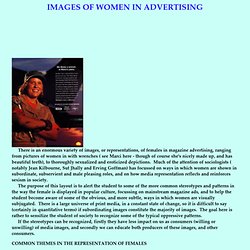

Images of Women. IMAGES OF WOMEN IN ADVERTISING There is an enormous variety of images, or representations, of females in magazine advertising, ranging from pictures of women in with wrenches ( see Marci here - though of course she's nicely made up, and has beautiful teeth), to thoroughly sexualized and eroticized depictions.

Much of the attention of sociologists ( notably Jean Kilbourne, Sut Jhally and Erving Goffman) has focussed on ways in which women are shown in subordinate, subservient and male pleasing roles, and on how media representation reflects and reinforces sexism in society. The purpose of this layout is to alert the student to some of the more common stereotypes and patterns in the way the female is displayed in popular culture, focussing on mainstream magazine ads, and to help the student become aware of some of the obvious, and more subtle, ways in which women are visually subjugated.
REFERENCESGoffman, Erving (1979). Gender Advertisements. Pink vs. Blue: Boys, Girls and the Toys They Love - On Parenting. Pink vs.

Blue: Boys, Girls and the Toys They Love Which came first: girls' love of everything pink or pink-packaged toys aimed at girls? That chicken-and-egg question is at the center of a small-scale study out of Britain that looks at how toys impact learning by gender. "People might think that toys are more androgynous these days, but go into any toy shop and you will find separate aisles, and even separate floors, for girls and boys," Becky Francis, professor of education at Roehampton University, told The Guardian last month.
"The packaging is geared towards either boys or girls by colour, wording and the images portrayed on them. In her look at toys and DVDs geared toward children ages 3 to 5, Francis first sought out favorites from preschoolers, as told by their parents in a questionnaire. These early toy preferences may point to later preferences in school achievement and ultimately professional choices, Francis says. What do you think? Women on Television. Television is widely known to represent and reinforce the mainstream ideology of contemporary western culture: patriarchy.

While television representations of women have changed greatly in the last twenty years alone, in order to accommodate the changing role of women in society, one is led to ask how much the ideology has changed behind the more modern representations of women. Television is regarded by many viewers to be the most 'real' form of media. If this is the case, then it is important for us to question how real the representations of women are on television and how this affects the attitudes of those who watch. Some of the most watched, and perhaps influential genres of television viewing are advertisements and soap operas, and it is these two forms of television that I will be largely focusing on throughout this essay.
In a world where women are numbered greater than men, can television be said to reflect the world as it is, or dictate to it? Bibliography November 1995. Beauty and Body Image in the Media. The Typical Woman in America: how women are portrayed in music, magazines, and reality t.v. Media Portrayals of Girls and Women. The Codes of Gender. Dossier: Gender - Gender and Society&-&Goethe-Institut& Kate Winslet: 'I Don't Look Like That And I Don't Desire To...